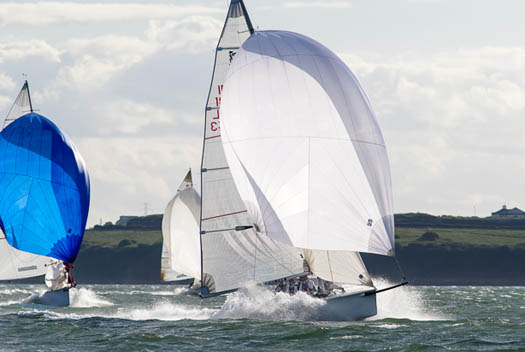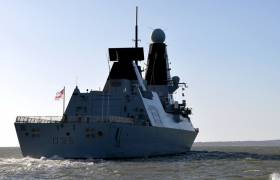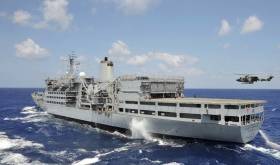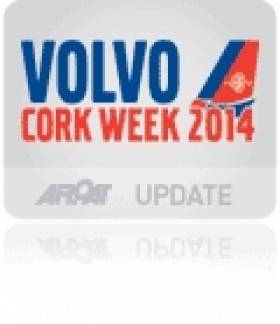Displaying items by tag: Volvo Cork week
Daring Dragon Destroyer Anchors During Volvo Cork Week
#DaringDragon - One of the UK’s most modern Royal Navy destroyers is also on a visit to Cork Harbour, having arrived yesterday afternoon, following that of a large auxiliary replenishment tanker-supply vessel, writes Jehan Ashmore.
The Type 45 ‘Daring’ Destroyer HMS Dragon (D35) displacing 8,000 tonnes is visiting as is the tanker RFA Fort Rosalie to coincide with Volvo Cork Week, hosted by the Royal Cork Yacht Club. In a new international services sailing competition, now part of Cork Week, Irish Defence Forces Team J19 yacht Joker 2 won the inaugural Beaufort Cup Fastnet Race out of 12 teams including those from the UK.
HMS Dragon which is on an anchorage call belongs to a class of six destroyers that are the backbone of the UK’s sea defence and on a worldwide basis. Primary roles are to hunt down on pirates, drug runners and submarines, in addition to defending the fleet from air attack and provide humanitarian aid after natural disasters.
RFA Fort Rosalie (A385), a Fort Class Solid Support Tanker of the Royal Auxiliary Fleet is berthed at Cobh’s deepwater berth, synonymous for cruise ships which this season sees 58 liners scheduled to call in 2016 bringing over 100,000 passengers and crew.
Likewise of RFA Fort Rosalie, the 152m long HMS Dragon is equipped with Phalanx systems, a key component in the arsenal of the navy. In addition is the principle anti-air missile, the Sea Viper which provides all-round defence. This is not just for the destroyer but for an entire naval task group and against all aerial threats some 70 miles away.
The Sea Viper can race towards its target at speeds in excess of Mach Four (over 3,000mph) using a series of tiny jets to manoeuvre, carrying out sharp turns at G forces no human could endure.
Note the ‘spinning egg’ atop the Type 45’s main mast which is a Sampson Radar that has a Combat Management System for long-range radar.
There is the Sylver missile-launching system on the destroyer's forecastle and Aster 15 and Aster 30 missiles with ranges up to 20 and 75 miles respectively.
Also mounted at the forecastle is the 4.5in main gun, found on all Royal Navy's destroyers and frigates, it is the most obvious provider of punch and firepower. The gun can fire up to two dozen high explosive shells, per minute, weighing more than 40kg (80lbs) at targets more than a dozen miles away.
The range can be extended to nearly 18 miles if special extended-range shells are used.
Large Royal Navy Supply Ship Sails in for Volvo Cork Week
#LargeUKvisitor - One of the largest UK naval vessels is at time of writing arriving into Cork Harbour this morning to coincide with Royal Cork Yacht Club’s Volvo Week, writes Jehan Ashmore.
The visit of RFA Fort Rosalie is also in the same year of the 70th anniversary of the foundation of the Irish Naval Service in 1946.
RFA Fort Rosalie (A385) is one of a pair of Fort Class Solid Support Tanker replenishment vessels of the Royal Fleet Auxiliary. She along with RFA Fort Austin and the overall RFA fleet also supply food, stores and ammunition to the Royal Navy fleet, whilst underway.
Also this morning, Naval Service CPV L.É. Orla, formerly HMS Swift of the Royal Navy Hong Kong Maritime Squadron met the 185m long auxiliary vessel off the entrance to Cork Harbour.
The RFA Fort Rosalie drawing 8m draft, had sailed from the French Naval Base at Brest, is to berth at Cobh’s deepwater quay.
Opposite of Cobh is Haulbowline Island where the Irish Naval Service Base is located and where the last major commemoration event, the 50th anniversary of the navy was held this month 20 years ago. On that occasion in July 1996 several foreign navies including the Royal Navy's HMS Manchester attended the 'Jubilee' event. The highlight I recall was the Fleet Review in Cork Harbour led by flagship L.É. Eithne.
The London registered 23,384 tonnes displacement RFA Fort Rosalie earlier this year at Portsmouth Naval Base assisted harbour tugs. This concerned an opportunity to put in some practice of towing large vessels ahead of the arrival next year of the 65,000 displacement tonnes HMS Queen Elizabeth.
One of the Aircraft Carrier Alliance contractors is Babcock International which to date has built the Naval Service OPV90 trio in which newbuild LE James Joyce is expected to be delivered next month.
As for the first of a pair of ‘QE’ new aircraft carriers under construction in Scotland, HMS Queen Elizabeth is to replace HMS Illustrious (see final Dublin call previously reported on Afloat.ie) Also see report on retirement as this year the UK's MOD announced that she is to be scrapped following the fate of her two ‘Invincible’ class sisters.
RFA Fort Rosalie is nearly 100m shorter and nearly three times lighter than the new carrier and sister HMS Prince of Wales. The Fort class auxiliary tanker-supplier ship is still considerably larger than any warship currently based in Portsmouth.
On the approaches to Portsmouth off the Nab Tower, some ten miles to the entrance to the port RFA Fort Rosalie was met by privately operated tugs from Serco, the Bountiful, Indulgent and Independent. The role of tugs had previously been part of RFA operations.
RFA Fort Rosalie built in 1978 and RFA Fort Austin each has a range of 10,000 miles at 20 knots, though the top speed can be 22 knots.
The Fort class have extensive aviation facilities, with 2 flight decks, one at the stern and one spot on top of the hanger. They have the ability to replenish at sea via 6 replenishment stations, three on each side as well as using helicopters for vertical replenishment (VERTREP).
Among defences, the pair have the Phalanx system, one of the deadly last lines of defence for the UK navy. Capable of engaging targets around one mile away, it is a radar-controlled Gatling gun which fires 20mm shells, that spews out 3,000 rounds a minute.
This is designed to engage incoming enemy aircraft and missiles if they penetrated a ship or task group's outer ring of defences such as Sea Viper or Sea Dart.
#volvocorkweek – A brief look over the entry list for Volvo Cork Week would suggest a challenging week ahead as the various fleets look forward to a competitive and enjoyable week of sailing at Royal Cork writes Claire Bateman. At the cutting edge in the big boat class there are several Ker 40's including Marc Glimcher's Catapult visiting Cork for the first time and Andy Williams' Keronimo a return visitor to Cork since 2013 with her distinct and easily recognizable 'HH' on the bow. Both these yachts will have to compete with Anthony O'Leary's Ker 39 Antix, just fresh from her victory at the British IRC National Championships. Also in this highly competitive grouping is Richard Matthews' highest rated boat in the fleet, GP42 Oystercatcher, accompanied by her mother ship the beautiful 125 ft.Oyster "Twilight".
Things don't get get any easier for those in Class Two with Conor and Denise Phelan's Ker 37 Jump Juice, fresh from her victory in the ICRA Nationals. She will have to compete with the Dowling/Boyd Quokka currently tuning up for her participation in the Irish Commodores' Cup Team. One should not underestimate the new X boat the Findlay/Anderson Roxstar who recently made her debut in Irish waters at the ICRA Nationals and with several First 40's adding to the mix, and a J120 to boot, should make for interesting competition.
Class Three, always a highly competitive class, includes nine J109's including Liam Shanahan's Ruth, pipped by seven minutes for a win in the recent Round Ireland, but she will have to compete with Ian Nagle's Jelly Baby also fresh from her recent win at the ICRA Nationals. Despite a recent disappointing performance at ICRA Nationals, one should never ignore the well sailed Robert McConnell's A35 Fool's Gold who certainly has the capacity to cause a major shake up.
Class Four will have its share of fiercely competitive and dedicated racing sailors including rivals Deasy/Desmond/Ivers Bad Company and T.E. Crosbie's No Excuse. Also included in this grouping will be the Dominic Losty IIlles Pitiuses, fresh from her recent Coutts Quarter Ton Cup Corinthian Victory and Judy McGrath's Hunter Impala Bonanza helmed by Barry Rose.

Royal Cork's own1720 class will be ar Volvo Cork Week, Photo: Bob Bateman
Now we come to the clash of the Sports Boats! Three Viper 640R's are making their way to Volvo Cork Week. This 21ft. sports boat, a very dinghy like boat, allows hiking and with the build having been taken over by Rondar since 2006, sports a carbon rig. These welcome visitors will compete with our own 1720s which made their first appearance in the April League 1994.
The White Sail fleet will sail in two classes on specially designed courses and it would be a brave person would make any pronouncements on who might emerge on top as this class appears to become more competitive with each passing day.
Practice Race Monday (7th). Official racing will commence Tuesday with the entire Volvo Cork Week Fleet competing in the hugely popular race that includes the highlight of a spectacular mark rounding off Cobh.
Indeed a mealy mouthful of racing to be enjoyed during the coming week.
British IRC Champ Returns to Home Waters for Volvo Cork Week
#corkweek – National Champions from Ireland, Great Britain will be in County Cork joining over 2000 sailors at the Royal Cork Yacht Club, Crosshaven for Ireland's longest running sailing regatta - Volvo Cork Week.
Class winners from the 2014 Irish and British National Championships will be racing at Volvo Cork Week in an international, adrenalin packed showdown in Cork Harbour and the Atlantic Approaches. An exciting line up of highly competitive yachts will be engaged in an intense battle at the Royal Cork Yacht Club's showcase event and enjoying the full hospitality of the world's oldest yacht club.
On the 15th June, Royal Cork's Anthony O'Leary racing Antix was the overall winner of the 2014 RORC IRC National Championship, held in Cowes, Isle of Wight. Antix won the nine-race championship in the very last race, against a top class international fleet from America, South Africa, Great Britain and Holland.
"A great win for Antix and the same team will be racing at Volvo Cork Week." commented Anthony O'Leary. "The competition will be just as good, in many respects even tougher, as a number of boats that were unavailable at the British championship will be coming to Cork. Antix will need to be at the top of their game, if we are to succeed."
Antix won the British championship in the very last race, just ahead of Premier Flair skippered by Jim Macgregor with his daughter and British Olympic sailor, Kate Macgregor on board and Premier Flair is a definite for Volvo Cork Week. Marc Glimcher's American Ker 40, Catapult was the class winner at Key west Race week before shipping over to Europe. Catapult was third in the RORC IRC Nationals this month and will be racing at Volvo Cork Week with double Olympian, Peter O'Leary, calling tactics. All three of these yachts will be vying for victory at Volvo Cork Week and they are joined by a number of proven winners including; Dutchman, Willem Wester racing Antilope, Andy Williams' Cornishman racing Keronimo and Quokka, chartered for Volvo Cork Week by Nial Dowling and Michael Boyd.
Top performers from the 2014 ICRA National Championship will be racing at Volvo Cork Week. Royal Cork YC members, Denise and Conor Phelan, are the 2014 Irish big boat champions with Jump Juice and fellow Royal Cork member, Ian Nagle was victorious at the Irish Championship with Jelly Baby. Royal Irish YC member, George Sisk will be racing WOW and Clyde CC member, Finlay Anderson will be bringing Roxstar down from Scotland.
Proven winners at Cork Week will also be returning including, Royal Irish YC member Paul O'Higgins with Rockabill V and West Mersea YC member, Richard Matthews with Oystercatcher XXX.
Volvo Cork Week is proud to announce that the latest range of Volvo Cars will also be on display in the event village, which will be open from Sunday 6th July for a special edition one-day dinghy regatta. Organised by the Royal Cork Yacht Club, the Dinghy Dash for Cash has a prize fund of €1000. The entry fee will be just €10 per boat and the closing date for entries is 1st July. The Dinghy Dash for Cash is an open event but limited to just the first 50 entries. Competitors can enjoy the hospitality of the Royal Cork Yacht Club and Volvo Cork Week Event Village.
Entries are still open for Volvo Cork Week.
































































